|
 ----------------------------------------------------
----------------------------------------------------

"Berimbau"
By N. Scott
Robinson and Richard P. Graham
The
Brazilian berimbau de barriga, or simply berimbau,
is a gourd-resonated, braced musical
bow of African origin. The instrument consists of a 4'–5'
(1.2 m–1.5 m) branch of biriba, bamboo, oak
or other wood bent into an arc. The bow is strung with a
single metal string, usually recycled from an industrial
use.
Attached
to the convex back of the bow with a small loop of string
is a gourd resonator, although coconut, calabash or a tin
can is occasionally substituted for a gourd. The string
loop also serves as a bridge, dividing the metal string
into two sections. The little finger of the musician’s
left hand (assuming a right-handed player) passes underneath
the string loop to hold the berimbau.
The string
is struck with a thin stick called a vaquita or
vareta, which is held in the player’s right
hand along with a small basket rattle called caxixi.
A small coin (dobrão) or stone (pedra)
held between the musician’s left thumb and index finger
is pressed to the string, resulting in a pitch change of
about a minor or major second above the berimbau’s
fundamental tone.
The berimbau
originated in an early nineteenth-century Brazilian slave
culture. Several historical notices and depictions from
this period demonstrate the continued presence of a variety
of central African musical bows (Koster 1816, 122; Graham
1824, 199; Walsh 1830, 175-176; Debret 1834, 39; Wetherell
1860, 106-107). Popular among African-Brazilian vendors
and street musicians, these musical bows were known by African
names such as urucungu, madimba lungungo,
mbulumbumba, and hungu (Shaffer 1976,
14; Kubik 1979, 30). As a result of pan-African technology-sharing,
organological traits of these various musical bows were
fused to create a single African-Brazilian instrument (Graham
1991, 6).
Sometime
in the late nineteenth century, this new musical bow received
a Lusophone name—berimbau de barriga, or
"jaw harp of the stomach"—and entered a new
cultural context, the African-Brazilian martial art form
known as capoeira (Kubik 1979, 30-33). Beginning
at least as early as the eighteenth century, capoeira
was fought to the music of an African-derived hand drum
or to simple handclapping. Capoeira is now fought
to the toques (rhythms) of the berimbau,
which accompany the songs known in Brazil as cantigas
de capoeira.
The musical
ensemble employed in contemporary capoeira features
one to three berimbaus, an atabaque (conical
hand drum), a pandeiro (tambourine) and an agogô
(double bell). Where multiple berimbaus are employed
in an ensemble, they are often tuned to separate pitches.
In Salvador de Bahia, the cultural epicenter of capoeira,
different names are used for berimbaus of various
sizes, including viola (small), medio
(medium) and gunga (large) (Lewis 1992, 137). From
the 1940s, a number of capoeira schools in Bahia
began to paint their berimbaus with colorful stripes
and other decorations, reflecting their pride in their individual
academias (traditional capoeira schools)
(Shaffer 1976, 26).
Richard
P. Graham
Boston, Massachusetts
The
Berimbau in Popular Music
Besides
its close association with capoeira, the berimbau
has long been used in a variety of Brazilian folk and popular
music forms, such as samba de roda, carimbo,
bossa nova, afro-samba and tropicalismo.
Art music composers such as Mario Tavares (Gan Guzama),
Luiz Augusto Rescala (Musica para Berimbau e Fita Magnetica)
and Gaudencio Thiago de Mello (Chants for the Chief)
have also written music for the instrument.
The berimbau
experienced a creative renaissance in 1960s Brazilian popular
music, followed by its spread to areas outside Brazil and
its use in 1970s international jazz. Although the international
diffusion of capoeira was a phenomenon that contributed
to the spread of the berimbau, this occurred only
after the instrument had already spread through popular
musics. As a result of Brazilian popular musical movements
in the 1960s, the berimbau began to be heard internationally
independently of capoeira. Baden Powell and others
brought the berimbau to the attention of musicians
outside Brazil in afro-samba songs that mimicked
the sound and rhythm of the berimbau on the guitar.
In 1962, Wilson das Neves of the samba-jazz group Os Ipanemas
used the berimbau extensively in a most creative
manner on their self-titled debut recording. Percussionist
Dom um Romão used the instrument on the track "Birimbau
(Capoeira)" in a samba-jazz big band on his debut recording
Dom Um in 1964. In 1965, Astrud Gilberto recorded
a jazz-bossa nova version of Powell’s "Berimbau"
that featured Dom um Romão on berimbau on
the recording Look
to the Rainbow. Gilberto Gil
recorded an important tropicalismo album in 1968
(titled Gilberto Gil), which featured the berimbau
with electric guitars on the song "Domingo no Parque."
Also in 1968, percussionist Naná
Vasconcelos was featured on Brazilian TV playing berimbau
with the group Trio
Nordeste. An unusual recording by
the vocalist Joyce of the Heitor Villa Lobos piece "Bachiana
Nº 5" for the 1970 television film Irmãos
Coragem (released on a soundtrack LP of the same name)
featured non-traditional berimbau. By 1970, the
berimbau had entered a variety of popular musics
in both Brazil and the United States.
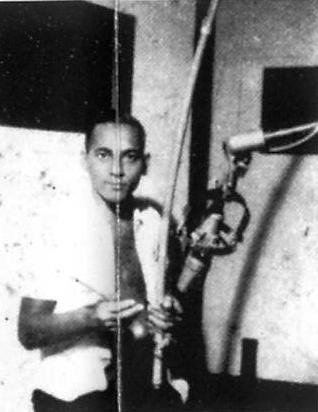
Wilson
das Neves recording with berimbau in 1962 on the
LP Os Ipanemas.
Several
expatriate Brazilian percussionists began the process of
reinterpreting the berimbau, using it outside of
capoeira in 1970s jazz, and this resulted in innovative
technical and organological developments. Airto Moreira,
Dom um Romão, Guilherme Franco and Naná Vasconcelos
[Juvenal de Hollanda Vasconcelos] had explored the possibilities
of using the berimbau in jazz, and they were followed
by Paulinho da Costa and Djalma Corrêa (and Papete
[José de Ribamar Vianna] and Chocolate Do Mercado
Modelo in Brazilian pop). Airto Moreira, who left Brazil
in 1968, played the berimbau on recordings by Miles
Davis in 1969, his solo recording in 1970, and played with
the group Weather Report in 1971. Dom um Romão replaced
Moreira in Weather Report and continued to use the berimbau
during a Japanese tour in 1972. Subsequently, Romão
developed an electric berimbau, which greatly increased
the volume of the instrument and allowed for subtle changes
in its timbre through the use of signal processors. Guilherme
Franco had been using the berimbau in an experimental
percussion trio in Brazil in 1972. After moving to New York,
he played the berimbau on jazz recordings by Archie
Shepp and McCoy Tyner and performed with The International
Percussion Quartet. After performing on berimbau
on Brazilian TV in 1968 with Trio Nordeste, Naná
Vasconcelos first recorded on the berimbau with
Milton Nascimento (for the film soundtrack Tostão,
a fera de ouro) and then with Luíz Eça
and Sagrada Família both in 1970, subsequently playing
the berimbau with Argentine Gato Barbieri in 1971,
and made three successive solo recordings between 1971-1973
in Argentina, France, and Brazil featuring extended improvisatory
solo pieces. Subsequently, non-Brazilian percussionists
extended the process of reinterpretation, playing the berimbau
in jazz. Among them were Luis Agudo and Onias Carmadelli
[also spelled as Camardelli] both from Argentina, Okay Temiz
from Turkey, African-American Bill Summers, American jazz
drummer Shelly Manne, Ray Armando from Puerto Rico, Curt
Cress from Germany, Alan Lee from Australia, and Marta Contreras
from France, among others.
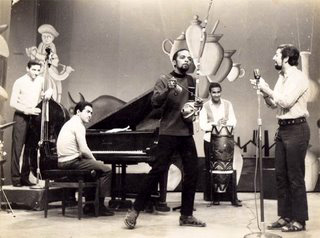
Naná
Vasconcelos and Trio Nordeste, Brazil TV, 1968

Naná
Vasconcelos & Gato Barbieri, 1971
The
use of the berimbau in jazz provided a nontraditional
context for contact, in which percussionists with little
or no experience with capoeira could freely exchange
ideas about berimbau techniques. Luis Agudo moved
to France in 1970, where he built his own berimbau
with a double caxixi and experimented with African,
Brazilian and Argentinean rhythms. While touring Europe,
Agudo met Okay Temiz in Sweden in 1974 and instructed him
in how to build a berimbau. By 1975, Temiz had
developed a completely new technical approach to the berimbau,
involving numerous effects pedals, microphones and a free-hand
grip similar to that used for the violin, where the instrument
is held between the chin and the shoulder, so that both
hands were free for playing. A similar cultural exchange
occurred through contact between Naná Vasconcelos
and percussionists in Italy and Japan. In the 1990s, Vasconcelos
performed a series of solo concerts and held workshops in
Japan and Italy. As a result of personal contact with Vasconcelos,
percussionists Seichi Yamamura of Japan [sometimes spelled
as Seiti Yamamura] and Peppe Consolmagno [Giuseppe Consolmagno]
of Italy began to play the berimbau in a style
heretofore peculiar to Vasconcelos, effectively contributing
to a kind of berimbau performance lineage.
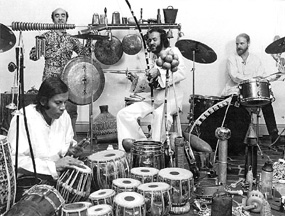
Guilherme Franco
- The International Percussion Quartet, c. 1970s
New
Berimbau Techniques
By
the 1990s, a number of organological developments and new
techniques were evident in the way that the berimbau
was played in popular musics. Tuning became an issue when
the berimbau was played in new musical contexts
where pitch was a consideration. Some musicians, such as
Vasconcelos and Temiz, actually tied the gourd resonator
to the wooden bow in a new manner, so that it was fixed
in place, keeping the pitch accurate. Brazilian Dinho Nascimento
built a large bass berimbau, called berimbum,
which used the string and tuning hardware of an acoustic
bass (American instrument makers Gino
Zenobia and Matt
Collins and German maker Anklang
Musikwelt continue to produce berimbau with
built in tuning hardware).
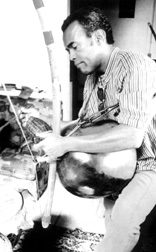

Dinho Nascimento
with berimbum, 2000
Another
organological development consisted of doubling the number
of strings, which required new performance techniques. Double-string
berimbaus were used by Vasconcelos, Temiz and Franco
(who also developed a double-berimbau—literally
two instruments joined as one). Romão, Temiz and
Franco developed electric berimbaus. Temiz also
developed an electric double-string berimbau that
featured the addition of separate microphones and signal
processors for the string, gourd and caxixi. His
technique involved using as many as nine signal processors
simultaneously in conjunction with a free-hand grip, which
allowed the left hand to slide the coin farther up and down
the string, producing many more than the traditional two
pitches. By amplifying each part of the berimbau,
Temiz could exploit other possibilities, such as tapping
on the gourd with the coin, fingers and stick, successfully
producing traditional Turkish rhythms.
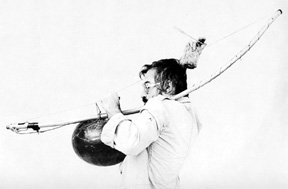
Okay Temiz - free-hand
grip & electric berimbau, 1983
Vasconcelos
expanded many technical aspects of the berimbau.
Such technical developments included plucking the string
with the fingers, striking the wood of the bow with the
stone, muting the string, scraping and striking the gourd
and other parts of the instrument with the stick, increasing
the number of pitches from two to three with a special angled
stone stroke, and playing inside the bow with the stick
by alternating between the wood and string, thereby achieving
many kinds of harmonics and percussive effects. He also
redefined the role of the caxixi. Keeping one rhythm
with the caxixi as an ostinato, the fingers of
the same hand played different accents on the string with
the stick. Similar techniques, and others, appear in Luiz
Almeida da Anunciação’s berimbau
method book of 1990. Argentine Luis Agudo and Brazilian
Dom um Romão both employed an unusual technique for
string bending by bracing the gourd against the body while
pulling back on the bow. In the 1990s, Dinho Nascimento
developed a blues-like slide-berimbau technique,
which involved holding the bow against the body in a free-hand
fashion so that a glass slide could be used to bend the
tones of the string. In the 1990s, Italian Rosario Jermano
developed another slide-berimbau technique that
called for a new left-hand grip and the use of a metal guitar
slide in place of the stone or coin. Through both a methods
book and teaching, Jermano’s technique spread to other
musicians in Italy, including percussionist Paolo Sanna.
Regarding
the slide-berimbau, other Brazilian musical bows
and monochords achieve a similar effect despite not being
a berimbau played with an innovative technique.
Airto Moreira experimented with a different musical bow
called berimbau de bacia on Flora Purim's 1974
recording 500 Miles High: Flora Purim at Montreux.
His incorrectly credited berimbau solo on the track
"Cravo e Canela" is in fact a berimbau de
bacia. This instrument is played horizontally by placing
a gourd-resonated musical bow on top of a bucket as an additional
resonator. The player's foot braces the wood of the bow
over the bucket with the string facing upwards. The string
is struck with a stick while the stone slides across the
string to achieve a much more melodic effect than the traditional
berimbau is capable of. Moreira also used this instrument
in duet with a didjeridu on the 2003 CD Life
After That. Antúlio Madureira has utilized the
marimbau de cabraça, a type of archaic Brazilian
glissed monochord, on several neo-traditional and popular
music recordings (refer to the Caetano Velôso track
"Rapte-me Camaleoa" on the Kelly Benevides 2001
CD Tráfego Local for an example of the marimbau
de cabraça in a popular music setting). Also
played horizontally, the marimbau (1 or 2 string
versions, also as marimbal) is not a musical bow
but is played with a stick and a slider achieving a melodic
effect that sounds similar to the berimbau de bacia
(as does the unrelated blues monochord from the southern
USA known as diddley bow or diddy bow). The innovative slide-berimbau
techniques employed on the traditional berimbau
are usually played in a vertical position.

Diddley
bow, monochord from USA

Marimbau,
monochord from Brazil

Rosario
Jermano's slide-berimbau grip, 1999
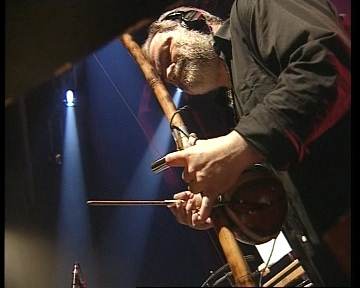
Rosario
Jermano's slide-berimbau grip
Both
inside and outside of Brazil, the berimbau is still
being used in new ways in popular musics. Brazilian artists
who have recently used the berimbau in heavy metal,
rap, electronica, and rock include Sepultura, Soulfly, Cyro
Baptista, General Frank, Gilberto Gil (with Gustavo di Dalva
on electric berimbau), and Mônica Feijó,
among others. Artists outside of Brazil that have also recently
used the berimbau in new genres include Tim Hurley
(USA, in the punk rock band Red Red Meat), Tim Aquilina
(USA, in the folk trio The Hitmen), Ramiro Musotto (Argentine
who plays tuned berimbau with club music electronica),
Santiago Vazquez (Argentine improvising percussionist),
Alex Pertout (Australia, orchestral and jazz), Mataro Misawa
(Japan, jazz), Joca Perpignan (Israel, in the folk group
Tucan Trio), François Malet (France, jazz), Nuno
Rebelo (Portugal, experimental film/dance/theater), Greg
Beyer (USA, composer of a multi-berimbau minimalist
piece in 2001 called Bahian Counterpoint (Homage à
Steve Reich) as well as commissioning pieces
for elaborately tuned berimbau in duo and sextet),
Douglas Geers (USA, composer of Exit to City for
berimbau and computer in 2003), Taufiq Qureshi
(India, fusion), Frank Colon (USA, jazz), Rich Goodhart
(USA, progressive world-rock), Richard P. Graham (USA, world
music), and N. Scott Robinson (USA, world music). The berimbau
has been used in new age and music therapy genres with recordings
by anthropologist Michael Harner of The Foundation for Shamanic
Studies, among others. The berimbau was also featured
in several films including Anselmo
Duarte's O Pagador de Promessas in 1962 and
the 1993 martial
arts/action film Only the Strong. In several television
commercials during the early 2000s, the automobile company
Mazda even used the capoeira song "Zum Zum
Zum" but changed it to "Zoom, Zoom, Zoom"
and included berimbau accompaniment in the popular
music soundtrack for its advertising campaigns.
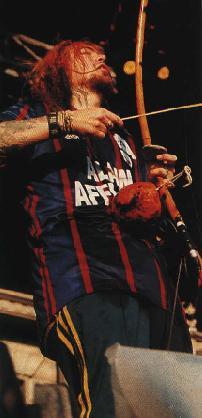
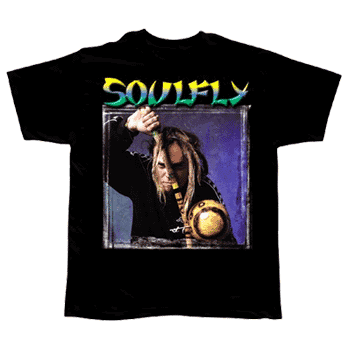
Max Cavalera of the
heavy metal groups Sepultura & Soulfly
Conclusion
The
berimbau has become somewhat emblematic of Brazilian
popular culture, its image appearing frequently in murals,
sculpture, jewelry, tattoos and the electronic media. The
diffusion of the berimbau into popular musics outside
of capoeira and beyond Brazil has led to its increased
sophistication and technical diversity as a musical instrument.
Because of the various styles of music in which the berimbau
was increasingly used, new techniques were developed to
better meet the challenges of berimbau performance
outside of capoeira. These new attributes of contemporary
berimbau performance include an increased tendency
toward improvisation, the use of electronics, additional
strings, combinations with new instruments, new rhythmic
styles, and solo performances. Following the innovations
of Brazilian percussionists, many non-Brazilian musicians
who creatively adopted the berimbau did so without
a prior knowledge of capoeira and approached the
instrument solely in the context of jazz and rock. Through
the process of reinterpretation, the increased range of
diverse performance techniques came to better fit the needs
of musicians who used the berimbau in new contexts,
and this facilitated the use of the instrument outside of
capoeira and beyond Brazil.
N. Scott
Robinson
San Diego Mesa College, California
[An
edited version of this article was published as "Berimbau"
in the Continuum
Encyclopedia of SPACE SPACE Popular
Music of the World, Volume 2: Performance and Production.
Edited by John SPACE
SPACEShepherd,
David Horn, Dave Laing, Paul Oliver, and Peter Wicke. New
York: SPACE
SPACE
SPACEContinuum,
2003, 345-349].
Bibliography
Anonymous.
"Okay Temiz." Pozitif (May 1991), 23-24.
________. "Okay
Temiz ile Söyleysi." Dans Müzik Kültür:
Folklora Dogru 62 (1996), 93-109.
________.
"A História do Berimbau" [The History of
the Berimbau]. Revista Capoeira 2, no. 7 SPACE
SPACE
(1999).
________.
"Dinho Nascimento: Fábrica de Sons" [Dinho
Nascimento: Maker of Sounds]. Mundo SPACE SCapoeira
1, no. 1 (May 1999), 10-11.
Almeida,
Bira [Mestre Acordeon]. Capoeira: A Brazilian Art Form
(History, Philosophy, and SPACE
SPACE
Practice).
Berkeley, CA: North Atlantic Books, 1986.
Amoruso,
Carol. "Cyro Baptista: Tarzan Percussionist of New
York’s Underground." Drum! 9, no. 5
SPACE (August/September 2000),
67-68, 70, 72, 75-76.
Balfour,
Henry. The Natural History of the Musical Bow.
Oxford: Clarendon Press, 1899.
Beyer,
Greg. "O Berimbau: A Project of Ethnomusicological
Research, Musicological Analysis, and SPACE
Creative Endeavor." DMA diss., Manhattan School
of Music, 2004.
________.
"Naná Vasconcelos: The Voice of the Berimbau."
Percussive Notes (October 2007): 48-52, SPACE
54, 56-58.
Capoeira,
Nestor [Nestor Sezefredo dos Passos Neto]. Capoeira:
Os Fundamentos da Malicia. Rio de SPACE
Janeiro: Susan Bach, 1992.
________.
The Little Capoeira Book. Berkeley: North Atlantic
Books, 1995.
________.
Capoeira: Roots of the Dance-Fight-Game. Berkeley:
North Atlantic Books, 2002.
Coelho,
Raquel. Berimbau. São Paulo: Editora Atica,
1993.
Consolmagno,
Peppe [Giuseppe Consolmagno]. "Il Berimbau" [The
Berimbau]. World Music 8, no. 33 SPACE
(August 1998): 44-52.
Cunha,
Tustão. "Como Montar e Cuidar do seu Berimbau"
[The Care and Assembly of a Berimbau]. SPACE
Batera & Percussão 4, no. 36
(August 2000), 44-45.
da
Anunciação, Luiz Almeida. "Birimbau from
Brazil: What is Birimbau and How to Play it?" SPACE
SPACE Percussionist
8, no. 3 (March 1971): 72-77.
________.
A percussão dos ritmos brasileiros sua técnica
e sua escrita. Caderno 1: O berimbau SPACE
(The Percussion Instruments of the Brazilian
Typical Rhythms: Its Techniques and its Musical SPACE
Writing. Book 1: The Berimbau). Rio de Janeiro:
Europa Empresa Gráfica e Editora, 1990.
Damaria,
Alexandre and Luiz Roberto Cloce Sampaio. O Berimbau-Brasileiro.
Everett: HoneyRock SPACE
Publishing,
2012.
de
Assis, Gilson. Brazilian Percussion. Munich: Advance
Music, 2003.
Debret,
Jean-Baptiste. Voyage pittoresque et historique au Bresil
[A Picturesque and Historical SPACESVoyage
to Brazil]. Paris: Firmin Didot Frères, 1834.
Faleiros,
Gustavo. "Papete: Música e Pesquisa" [Papete:
Music and Research]. Batera & Percussão
4, SPACE no. 32 (April 2000),
16-20.
Galm,
Eric A. "The Berimbau de Barriga in the World
of Capoeira." M.A. thesis, Tufts University, SPACE
1997.
________.
"Beyond the Roda: The Berimbau de Barriga
in Brazilian Music and Culture." Ph.D. diss., SPACE
Wesleyan University, 2004.
________.
The Berimbau: Soul of Brazilian Music. Jackson:
University Press of Mississippi, 2011.
________.
"Tension and 'Tradition:' Explorations of the Brazilian
Berimbau by Naná Vasconcelos, SPACE
Dinho Nascimento, and Ramiro
Musotto." Luso-Brazilian Review 48, no. 1
(2011): 79-99.
Germinario,
Fabio. "Luis Agudo." Jazzit 3, no. 6
(September/October 2001), 48-50, 52-53.
Gillette, Phillip."Airto Moreira and the Role of Brazilian Percussion in Early Jazz Fusion." M.A thesis, SPACE William Paterson University, 2021.
Gomes,
Sergio. "O berimbau" [The Berimbau]. Batera
& Percussão 4, no. 36 (August 2000), 40-42.
Graham,
Maria. Journal of a Voyage to Brazil. London: Longman,
1824.
Graham,
Richard. "Technology and Culture Change: The Development
of the Berimbau in Colonial SPACE
Brazil." Latin American Music Review
12, no. 1 (Spring/Summer 1991): 1-20.
Graham,
Richard and N. Scott Robinson. "Historical and Musical
Introduction to the Berimbau." LP SPACE
Highlights in Percussion 3, no. 1 (1988),
14, 16.
Herskovits,
Melville J. The Myth of the Negro Past. Boston,
MA: Beacon Press, 1958.
Jermano,
Rosario. 'Slide Berimbau'—Nuova Technica per suonare
il Berimbau ['Slide Berimbau'— SPACE
New Technique for Playing the Berimbau].
Rome: Rosario Jermano, 1999.
Koster,
Henry. Travels in Brazil. London: Longman, 1816.
Kubik,
Gerhard. Angolan Traits in Black Music, Games and Dances
of Brazil: A Study of African SPACE
Cultural Extensions Overseas. Lisbon:
Junta de Investigações Científicas
do Ultramar, 1979.
Lemba,
Deo. Meu Berimbau Instrumento Genial. Salvador:
Deo Lemba, 2002. [Instructional book & SPACE
CD].
Lewis,
J. Lowell. Ring of Liberation: Deceptive Discourse in
Brazilian Capoeira. Chicago: University SPACE
of Chicago
Press, 1992.
Merrell,
Floyd. Capoeira and Candomblé: Conformity and
Resistance Through Afro-Brazilian SPACE
SPACE
Experience.
Princeton: Markus Wiener Publishers, 2005.
Moreira,
Airto. Airto: The Spirit of Percussion. Wayne,
NJ: 21st Century Music Productions, 1985.
Nazário,
Zé Eduardo. "Entre Amigos: Zé Eduardo
Nazário entrevista Guilherme Franco" [Between
SPACE Friends: Zé
Eduardo Nazário Interviews Guilherme Franco]. Batera
& Percussão 4, no. 38 SPACE
(October 2000), 54-56.
Pellegrini,
Cecília. "Dinho Nascimento: Gongolô."
Revista Capoeira 2, no. 9 (2000), 28-29.
Pinto,
Tiago de Oliveira, editor. Brasilien: Einführung
in Musiktraditionen Brasiliens [Brazil: An SPACE
Introduction to the Music Tradition of Brazilians].
New York: Schott, 1986.
Rego,
Waldeloir. Capoeira Angola: ensaio sócio-etnográfico
[Capoeira Angola: Socio-Ethnographic SPACE
Essay]. Rio de Janeiro: Gráffica
Lux, 1968.
Robinson,
N. Scott. "Rhythm Legend Airto: Then & Now."
Modern Drummer 24, no. 6 (June 2000), SPACE
68-72, 74, 76, 78, 80, 82.
________.
"Naná Vasconcelos: The Nature of Naná."
Modern Drummer 24, no. 7 (July 2000), 98-102, SPACE
104, 106, 108.
________.
"The New Percussionist in Jazz: Organological and Technical
Expansion." M.A. thesis, SPACE
Kent State
University, 2002.
________.
"Okay Temiz: Drummer of Many Worlds." Percussive
Notes 41, no. 4 (August 2003): SPACE
28-30, 32-34.
Robinson,
N. Scott and Richard Graham. "Berimbau."
Continuum Encyclopedia of Popular Music of SPACE
the World,
Volume 2: Performance and Production. Edited by John
Shepherd, David Horn, SPACE
Dave Laing,
Paul Oliver, and Peter Wicke. New York: Continuum, 2003,
345-349.
Rocca,
Edgard Nunes "Bituca." Escola Brasileira de
Música: uma visão Brasileira no ensino da SPACE
SPACE
música-ritmos
Brasileiros e seus instrumentos de percussão 1.
Rio de Janeiro: EBM, 1986.
Roisman,
Eli. "Dinho Nascimento: O mago do Berimbau" [Dinho
Nascimento: The Magician of the SPACE
Berimbau]. Batera & Percussão
4, no. 38 (October 2000), 32-34, 36.
Shaffer,
Kay. O berimbau-de-barriga e seus toques [The Berimbau
and Its Rhythms]. Rio de Janeiro: SPACE
Ministerio da Educação e Cultura,
1976.
Sharp, Daniel. Naná Vasconcelos' Saudades. New York: Bloomsbury, 2021.
Walsh,
Robert. Notices of Brazil in 1828 & 1829. London:
F. Westey & A.H. Davis, 1830.
Wetherell,
James. Brazil—Stray Notes from Bahia: Being Extracts
from Letters, & C., During a SPACEResidence
of Fifteen Years. Liverpool: Webb and Hunt, 1860.
Discography
Agudo,
Luis. Afrosamba & Afrorera. CD, Red RR123185.
1980/1984: Italy.
Agudo,
Luis and Afonso Vieire. Jazz a Confronto 33. LP,
Horo HLL 101-33. 1975: Italy.
Anderson,
Marc. Time Fish. CD, East Side Digital ESD 80842.
1993: USA.
Anugama.
Spiritual Environments: Shamanic Dream. CD, Higher
Octave 321. 2000: USA.
Australian
Art Orchestra and Sruthi Laya Ensemble. Into the Fire.
CD, ABC Classics ABC 465 705-2. SPACE
2000: Australia.
Baker,
Ginger. Horses & Trees. CD, Terrascape TRS
4123-2. 1986: USA.
Baptista,
Cyro. Vira Loucos: Cyro Baptista Plays the Music of
Villa Lobos. CD, Avant AVAN 061. SPACE
1997: Japan.
Benevides,
Kelly. Tráfego Local. CD, Via Som Music
VS 200215. 2001: Brazil.
Bernstein,
Chuck. Delta Berimbau Blues. CD, CMB Records 102844.
2009: USA.
Brock,
Jim. Pasajes. LP, Mbira MRLP-1001. 1988: USA.
Carmadelli,
Onias. Eu Bahia: Atabaque e Berimbau. LP, Philips
6470003. 1972: Brazil.
Codona.
Codona 2. CD, ECM 1177 78118-21177-2. 1981: USA.
Consolmagno,
Peppe [Giuseppe Consolmagno]. Timbri Dal Mondo.
CD, Cajù 4158-2. 1999: Italy.
Corrêa,
Djalma. Djalma Corrêa e Banda Cauim. LP,
Barclay 821 375-1. 1984: France.
da Costa,
Paulinho. Agora. CD, Pablo OJCCD-630-2 (2310-785).
1976: USA.
Daniele,
Pino. Pino Daniele. LP, EMI 3C 064-18391. 1979:
Italy.
Davis,
Miles. The Complete Bitches Brew Sessions. CD,
Columbia C4K 65570. 1969: USA.
________.
Big Fun. CD, Sony SRCS 5713. 1969/1972: USA.
de
André, Fabrizo. In Concerto (live). CD,
Ricordi 74321656992. 1999: Italy.
de
Oxossi, Camafeu. Berimbaus da Bahia. LP, Musicolor
104.405.016. 1967: Brazil.
Deguchi,
Khorey. Blowin’ Green Breeze. CD, MAHORA Japan
MFS-5801. 2000: Japan.
Eça,
Luíz and Sagrada Família. Onda Nova do
Brasil. CD, Lazarus Audio Products CD-2015. 1970: USA
SPACE (originally
released on LP as La Nueva Onda del Brasil on RVV
RVV-1136 in Mexico by Luiz SPACE
Eca Y
La Familia Sagrada).
Eloah.
Os Orixas. LP, Som Livre 403.6153. 1978: Brazil.
Favata,
Enzo. Il cielo è sempre piu' blu. CD, San
Isidro SND 1001-2. 1996: Italy.
Feijó,
Mônica. Aurora 5365. CD, Sonopress MRO178.
2000: Brazil.
Felicidade
a Brasil. Felicidade a Brasil. CD, Pulp Flavor
M01221635. 1973: France.
Floridos,
Floros with Nicky Skopelitis and Okay Temiz. Our Trip
So Far. CD, M Records SPACE
SPACE
SPACE 520167601013.
2000: Greece.
Franco,
Guilherme. Capoeira: Legendary Music of Brazil.
CD, Lyrichord 7441. 1997: USA.
Gil, Gilberto.
Gilberto Gil. LP, PolyGram 1029. 1968: Brazil.
Gilberto,
Astrud. Look to the Rainbow. CD, Verve 821556-2.
1965: USA.
Goodhart,
Rich. The Gathering Sun. CD, Beginner’s Mind
Productions BMP 0404. 1999: USA.
Graham,
Richard P. Lexicon. Cassette, Bearsville Music
01. 1988: USA.
Guzman,
Viviana. Planet Flute. CD, Well-Tempered 5187.
1997: USA.
Harmer,
Michael. Shamanic Journey Tapes: Musical Bow for the
Shamanic Journey. Cassette, SPACE
SPACE
The Foundation
for Shamanic Studies No. 6. 1991: USA.
Headhunters,
The. Survival of the Fittest. CD, BMG France 74321409522.
1975: USA.
Holland,
Mark & N. Scott Robinson. Wind & Fire.
CD, Cedar n Sage Music CS 7514. 2009: USA.
________.
Lost In The Beauty Of It All. CD, Cedar n Sage
Music CS 7517. 2013: USA.
Ipanemas,
Os. Os Ipanemas. CD, Mr. Bongo MRBCD001. 1962:
Brazil.
Jobim,
Antonio Carlos. Urubu. LP, Warner Archives BS-2928.
1976: USA.
Jones,
Elvin. Mr. Thunder. LP, East West EWR7501. 1974:
Sweden.
Jones,
Marti. Used Guitars. CD, A&M 5208. 1988: USA.
Klug,
Slats and Friends. A Brown County Christmas, Volume
Two. CD, Rebo Music 1231. 2001: USA.
Kodo.
Mondo Head. CD, SME SICP-1. 2001: Japan.
Kokelaere,
François. Berimbau: The Art of Berimbau (Brazilian
Musical Bow). CD, Musique du Monde SPACE
92678-2. 1993:
France.
L.A.
Four, The. The Scores. CD, Concord Jazz 6008. 1974:
USA.
Leonhart,
Michael. Glub Glub Vol. II. CD, Sunnyside SSC 1077.
1996: USA.
Liotta,
Saro. L’attesa. LP, RCA TPL1-1209. 1976: Italy.
Lunar Bear
Ensemble. Lunar Bear Ensemble. CD, Muworks CD 1006.
1988: USA.
Maeda,
Yuki. Jazz Age: Gershwin Song Book I. CD, Ewe EWCD002.
1997/1998: Japan.
Maria,
Marcia. Marcia Maria. LP, Capitol 31C 062 421130.
1978: Brazil.
Mendilow,
Guy. Live. CD, Earthen Groove Records EGR003. 2004:
USA.
Mendes,
Sergio. Primal Roots. LP, A&M 4353. 1972: USA.
Metheny,
Pat and Lyle Mays. As Falls Wichita, So Falls Wichita
Falls. CD, ECM 78118-21190-2. SPACE
SPACE 1981: USA.
Moraz,
Patrick. Patrick Moraz. LP, Charisma 0798. 1978:
UK.
Moreira,
Airto. Natural Feelings. LP, Buddah BDS-21-SK.
1970: USA.
________.
Life After That. CD, Narada World 724359326726.
2003: USA.
Musotto,
Ramiro. Sudaka. CD, Fast Horse 5. 2003: USA.
Nascimento,
Dinho. Berimbau Blues. CD, Velas V 20166. 1996:
Brazil.
________.
Gongolô. CD, Genteboa GB 002. 2000: Brazil.
Nascimento,
Milton. Tostão, a fera de ouro. LP, Odeon
7BD1202. 1970: Brazil.
________.
Miltons. CD, Columbia CK 45239. 1989: USA.
OM. OM
with Dom um Romão. LP, ECM 19003. 1977: USA.
Oriental
Wind. Life Road. CD, JA & RO 08-4113. 1983:
Sweden.
Papete
[José de Ribamar Vianna]. Berimbau e Percussão:
Music and Rhythms of Brasil. CD, Universal SPACE
Sound US CD7.
1975: Brazil.
________.
Planador. LP, Continental 1.01.404.244. 1981: Brazil.
Passport.
Iguaçu. CD, Wounded Bird WOU 149. 1977:
USA.
Pertout,
Alex. Alex Pertout. CD, Larrikin Entertainment
LRJ-273. 1993: Australia.
________.
From the Heart. CD, Vorticity Music VM 010116-1.
2001: Australia.
Pike
Set with Baiafro, The New Dave. Salomão.
LP, MPS MB-21541. 1972: Germany.
Powell,
Baden. Os Afro-Sambas. CD, Forma FM-16. 1965: Brazil.
Purim,
Flora. 500 Miles High: Flora Purim at Montreux.
CD, Milestone OJCCD-1018-2 (M-9070). SPACE
1974: USA.
Qureshi,
Taufiq. Rhydhun: An Odyessy of Rhythm. CD. CMP
CD 81. 1995: India/Germany.
Rebelo,
Nuno. Azul Esmeralda. CD, Ananana AN-LLL0001-CD.
1998: Portugal.
Redmond,
Layne and Tommy Brunjes. Trance Union. CD, Golden
Seal CD 0100. 2000: USA.
Red Red
Meat. There’s a Star Above the Manger Tonight.
CD, Sub Pop 387. 1997: USA.
Robinson,
N. Scott. World View. CD, New World View Music
NWVM CD-01/United One U1CD 402 SPACE
4569 3027 2.
1994: USA/Germany.
________.
Things That Happen Fast. CD, New World View Music
NWVM CD-02. 2001: USA.
Romão,
Dom um. Dom Um. LP, Mercury 528 122-1. 1964: Brazil.
Rudolph,
Adam. Adam Rudolph’s Moving Pictures. CD,
Flying Fish FF 70612. 1992: USA.
Sepultura.
Roots. CD, Roadrunner 8900. 1996: USA.
________.
Under a Pale Grey Sky. CD, Roadrunner 618436. 2002:
USA.
Shepp,
Archie. The Cry of My People. LP, MCA 23082. 1972:
USA.
Soulfly.
Soulfly. CD, Roadrunner 8596. 1998/1999: USA.
________.
Primitive. CD, Roadrunner 8512. 2000: USA.
________.
3+4. CD, Roadrunner International 84555. 2002:
USA.
________.
Tribe. CD, 404 Music Group 8020. 2002: Australia.
Temiz,
Okay. Drummer of Two Worlds. LP, Finnadar SR 9032.
1975/1980: Turkey.
________.
Oriental Wind. LP, Sonet SNTF 737. 1977: Sweden.
________.
Magnet Dance. CD, Tip Toe TIP-888819-2. 1994: Germany.
________.
Okay Temiz’s Magnetic Band: Magnet Dance.
CD, Vasco de Gama VDFCD 8000. SPACE
SPACE
1994: Turkey.
Tibbetts,
Steve. Exploded View. CD, ECM 1335 831 109-2. 1986:
USA.
Tucan Trio.
Tucan Trio. CD, Nada NADA 16. 2000: Israel.
Various
Artists. The Discoteca Collection: Missão de
Pesquisas Folclóricas. CD, Rykodisc RCD 10403.
SPACE 1938:
Brazil.
________.
Folklore e Bossa Nova do Brasil (Jazz Meets the World
1: Jazz Meets Brasil). CD, MPS SPACE
533 133-2.
1966: Germany.
________.
Irmãos Coragem.
LP, Philips 765.119. 1970: Brazil (unidentified berimbau
player).
________.
Berimbau e Capoeira—BA. CD, Documentario Sonoro
do Folclore Brasileiro INF 46. SPACE
1988: Brazil.
Vasconcelos,
Naná. Africadeus. CD, Saravah SHL 38. 1972:
France.
________.
Amazonas. LP, Phonogram 6349.079. 1973: Brazil
________.
Saudades. CD, ECM 1147 78118-21147-2. 1979: USA.
________.
Nanatronics: Rekebra/Nanatroniko. LP (12"
single), Bagaria BAG-X 0190784. 1984: Italy.
Vasconcelos,
Naná and Agustin Pereyra Lucena. El Increible
Naná con Agustin Pereyra Lucena. SPACE
SPACE
LP, Tonodisc
TON-1020. 1971: Argentina.
Vazquez,
Santiago. Raamón. CD, Lal 025. 2004: Argentina.
Veloso,
Caetano. Transa. CD, Polygram 838511. 1972: Brazil.
Voicequn.
Peace Birthday. CD, Funny Time Label & Records
SB-202. 2002: Japan.
Watson,
David. Skirl. CD, Avant 77. 1999: USA.
Weather
Report. Weather Report. CD, Columbia/Legacy CK-48824.
1971: USA.
________.
Live in Tokyo. CD, Sony International 489208-2.
1972: Japan.
Yamamura,
Seichi. Voice of TEN. CD, Funny Time Label &
Records HOC-356. 1997: Japan.
Videography
Acuña,
Alex. The Rhythm Collector. 2007. Drum Workshop
(DVD). (Alex Acuña-berimbau).
Almeida,
Bira [Mestre Acordeon]. Capoeira Bahia. 1983. World
Capoeira Association (video).
Cortesão, Jorge. The Berimbau—volume 1.
1999. Bridges to Productions (video).
________.
The Berimbau—volume 2. 1999. Bridges to Productions
(video).
Damaria,
Alexandre and Luiz Roberto Cloce Sampaio. O Berimbau-Brasileiro.
Everett: HoneyRock SPACE
Publishing,
2012.
Duarte,
Anselmo. O Pagador de Promessas. 1962 (film).
Duarte,
Cassio. Introduction to Brazilian Percussion. 2003.
LP LPV136-D (DVD).
Gil,
Gilberto. Electracústico. 2004. WEA 5050467761025
(DVD & CD set).
Lenine
(Oswaldo Lenine Macedo Pimentel). Cité.
2004. BMG AA0025000 (DVD).
Lettich,
Sheldon (director). Only the Strong. 1993. 20th
Century Fox (DVD).
Moreira,
Airto and Flora Purim. The Latin Jazz All-Stars Live
at the Queen Mary Jazz Festival. SPAC1985.
View NTSC1311 (video).
Musotto,
Ramiro. Sudaka: Ao Vivo. 2005. MCD MCD 304 (DVD
& CD set).
Santo,
Joselito Amen. Sounds of Bahia: Introduction to Berimbau.
2006. Play My Game (DVD).
Sembello,
Michael. The Bridge. 1998. PBS (video).
Various
Artists. Bahia de Todos os Sambas. 1983. Sagres
(video).
________.
Woodstock Jazz Festival. 1981. Pioneer Artists
PA-98-596-D (DVD).
________.
The Spirit of Samba: Black Music of Brazil. 1982.
Shanachie (video).
________.
The JVC Video Anthology of World Music and Dance. Vol.
28: The Americas 2. 1988. SPACE
JVC, Victor
Company of Japan (video).
________.
Batouka: First International Festival of Percussion.
1989. Rhapsody Films (video).
________.
The Music of Jimi Hendrix. 1995. TDK (DVD).
________.
Pernambuco em concerto. 2000. África Produçoes
(video).
Vasconcelos,
Naná. Berimbau. 1971. New Yorker Films (documentary
film).
________.
Goree, On the Other Side of the Water. 1990. UNESCO
(documentary film).
©2000
- N. Scott Robinson. All rights reserved.
|

